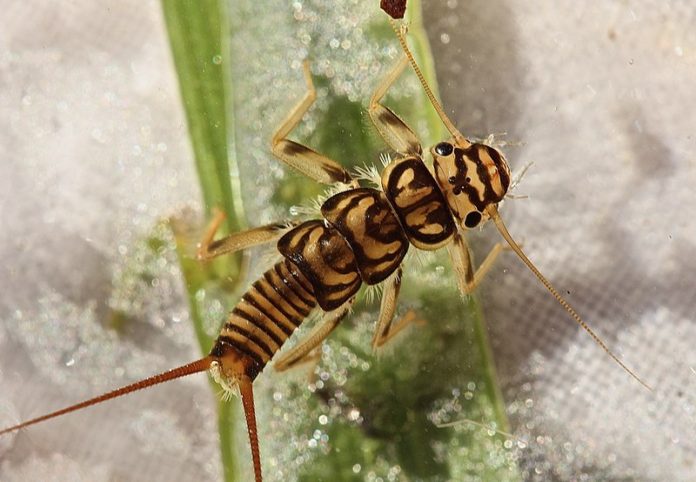Fly fishing is a sport that often defines itself by the minute scale of the patterns that anglers present to finicky trout, and it’s not unusual to hear an “expert” brag about his success casting size 24 or 26 midges on tiny tippets. But at the other end of the scale are the stoneflies (order Plecoptera), a group of insects prized for their sheer bulk, which dwarfs that of most mayflies and caddisflies. A turned-over a rock on a freestone stream can yield several species of insect larvae, but stoneflies will immediately stand out because they are often several times larger than anything else. Imitations of these outsize larvae are favorites of anglers who believe that “big flies equal big fish,” as well as for those fishing during high water.
What’s in a Name?
The common name “stonefly” is almost certainly a reference to the kinds of streams in which the larvae of many species are found—freestone rivers that feature rocky substrate and well-oxygenated, clean water. It makes sense that the order’s common name should be derived from the most common habitat of the nymphs, since many stoneflies exist in the larval stage from one to three years and their discarded nymphal shucks are often found on stones in midstream or along the bank. The Latin name Plecoptera comes from the Ancient Greek for “braided wings,” and is based on the way the four heavily veined wings of the adult lie atop one another along the insect’s back. Strange that the insect should be named for its wings, since the large insects are such clumsy fliers.
Life History and Habitat
There are approximately 3,500 species of stoneflies worldwide, and they are widespread, found on every continent except Antarctica. In North America, there are close to 600 species, ranging from the diminutive slender winter stonefly (family Capniidae) to the monstrous Western salmonfly (Pteronarcys californica), whose larvae can grow to longer than two inches.
The Western salmonfly is a clumsy flier and a big meal for a trout.
Photo by Phil Monahan
Taxonomists usually divide stoneflies into two suborders: Euholognatha, which includes four families in North America, generally hatch more heavily in winter and spring; and Systellognatha, of which there are five families in North America, hatch in summer. Of the former group, the ones that fly fishers will best recognize include slender winter stonefly and early brown stonefly (Strophopteryx fasciata). Systellognatha includes the giant black stonefly (P. dorsata) of the East and Midwest, and the classic Western salmonfly and golden stoneflies (Family Perlidae).
The stonefly life cycle involves an incomplete metamorphosis, which means that there is no pupal stage, and the nymphs look much like the adults. In general, the larger the species, the longer larval development takes, with some species spending three years in this stage and molting more than 20 times. (The stages between molts are called “instars.”) When it’s time to hatch into winged adults, most stoneflies migrate to the bank and climb out of the water before transforming; they do not hatch on the water’s surface, like most species of mayflies and caddisflies. This is one reason that nymph imitations are more popular among fly fishers than patterns that mimic the adults. Most of the time, adults are available to trout only when they are blown onto the water—which is fairly often, given their poor flying skills—and during egg-laying.
Because many Plecoptera nymphs get oxygen from the water via filamentous gills, they are intolerant of pollution. In fact, the presence of a healthy stonefly population is seen as an indicator of good water quality. This is somewhat ironic, since stoneflies are closely related to cockroaches, which are seen as evidence of filth. Although most species prefer swift well-oxygenated water, there are species that inhabit the leaf litter at the bottom of slow-moving stretches and even a few whose larvae live on land in wet environments.
Patterns and Tactics
According to W. Patrick McCafferty’s Aquatic Entomology, the oldest artificial fly on record was an imitation of a British stonefly adult. While today there are many popular adult patterns—the Stimulator chief among them—that number is dwarfed by the nymph options available to anglers: from close imitations, such as the Kauffman Stone, to more suggestive patterns, such as Pat’s Rubberlegs. Even a small Woolly Bugger, fished on a dead-drift can serve as an effective stonefly pattern.
The one common denominator among stonefly-nymph patterns is that they are usually heavy, incorporating weighted wire into the body or a metal bead (or two). Since stonely larvae are crawlers—and relatively poor swimmers—they stay close to the bottom, which is where your fly needs to be. Before emergence, many species migrate toward shore, and a nymph imitation crawled or swing from deeper water to the shallows can take trout or bass keying on this migration.
Credit: Source link































